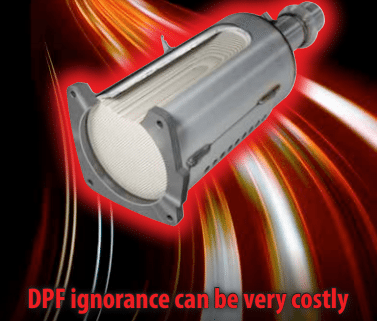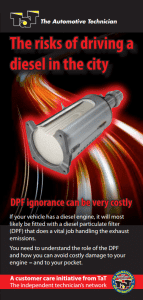What is a Diesel Particulate filter and should I buy a car that has one?
Although diesel engines are light years more refined than those of previous decades, to meet ever tightening emissions regulations car makers have to employ several different technologies – one of these is a Diesel Particulate Filter (DPF).
A DPF’s main function is to catch particles, which can later be burnt at extremely high temperatures, resulting in lower emissions. The main particle caught is soot (black carbon) – soot is the result of partially burnt diesel – the black stuff you often see bellowing out of diesel exhaust at high load.
A differential pressure sensor monitors the pressure before and after the DPF, creating a reading so the car’s engine management computer knows what level of blockage the DPF is at so it can use its regeneration strategies to burn the particles off to a gas which will pass through the walls of the DPF and out the exhaust, clearing the filter and ready to start the process all over again.
The 3 main regeneration strategies used by all cars with DPF’s are –
- Passive regeneration – This is the best case scenario. During normal engine operation under certain conditions and usually aided by mounting the DPF close to the engine and in conjunction with a catalyst, there is enough heat built up in the DPF to burn the particles without any extra action taken by the computer.
- Active regeneration – If pressure continues to build in the DPF over normal driving, the computer will take a variety of steps to raise temperatures high enough to burn the particles. Strategies used my manufacturers include –
- Increasing exhaust temperature through late fuel injection or injection during the exhaust stroke
- A fuel burner after the turbo to increase the exhaust temperature
- Use of a fuel borne catalyst to reduce soot burn-out temperature – commonly used by BMW and MINI in the form of EOLYS additive
- Heating coils or microwave energy to increase the exhaust temperature
- Service regeneration – If pressure continues to increase, usually due to the previous efforts failing due to short stop start driving not conducive to high temperatures, the final attempt involves a technician using a scan tool to manually command the engine management computer to employ aggressive strategies at a standstill to burn the particulates. Procedures developed by leading UK based trainer Frank Massey also allow us to utilise our BG Diesel Induction Cleaning System to aid this process. This is a last ditch attempt to clear the DPF, failure will result in blockage so severe that any further attempts to clear the DPF would result in dangerously high temperatures that will likely damage the system. At this point, the only options are removal of the DPF for off car specialist refurbishment or replacement of the DPF.
It is important to understand why the DPF has blocked to avoid further failures. The DPF is a filter so usually it is simply doing the job it is designed for and the problem lies much further up the line. Failure to cure the root cause of the problem will result in the new DPF becoming blocked too.
The most common cause of DPF’s blocking is poor driving habits. If you drive your DPF equipped diesel vehicle at low speeds, around town, for short periods of time, you are only asking for trouble. The nature of the system explicitly requires high temperatures, achieved at high loads that just won’t happen at idle or low speeds. The best thing you can do if you are seeing any DPF related warning lights (consult your vehicle’s owners manual) is to take your car on a highway drive (or at least over 65km/h as a bare minimum) for over 15 minutes – if the problem persists there is likely a deeper fault that will require a visit to the mechanic.
We have all seen a diesel blowing black smoke out the exhaust, quite a lot when something is wrong. This all still happens, however now all this soot gets caught in the DPF, which can block it quite rapidly. For this reason many customers with less than perfect running diesels can continue driving none the wiser, as there is no black smoke coming out the exhaust. When the DPF inevitably blocks it is imperative that the root cause is fixed or the car will return quickly as the DPF blocks again. Every fault that affects old diesels is still relative on today’s modern engines, there are hundreds of possible problems – intake hoses still leak, injectors work much harder and wear much quicker, increased Exhaust Gas Re-circulation strategies block intakes with restrictive carbon – all of these plus countless other possible problems will result in increased particles and quickly block a DPF.
So should I buy a car with a DPF?
Emissions regulations are now so tight, that even the manufactures who managed to dodge using a DPF in recent years have had to concede to using one to meet these standards. Every current model diesel vehicle that you can purchase uses a DPF as just one among many exhaust after treatment technologies to meet emissions. If you regularly travel sustained distances over 70km/h for over 10 minutes minimum, with no periods of slowing in between, then a diesel vehicle can be a great choice for you, the fuel economy savings and low down torque may be just what you are looking for. However, if you regularly travel shorter trips, at speeds under 70km/h, this technology just will not work without your assistance, so as a minimum we would recommend you take at least one highway journey at least once a fortnight – an excuse to get out on the open road and take advantage of Australia’s beautiful sights.
As a final comment, my opinion is that with these necessary but restrictive emissions regulations posed on new diesels, we are winding our way to the death of the diesel passenger light vehicle. Europe was the first to embrace small diesel cars for their fuel economy, but evidence is clear that diesel vehicle sales are on the decline as customers wise up to just how expensive it can be when things go wrong, particularly when driven in city situations. The DPF cops a lot of the negative feelings, but unfortunately for all the great work it does it just happens to be the last thing in the line that cleans up the mess made by any other failing component. In a world pushing towards cleaner emissions, sadly our low down torque towing partner, diesel, is reaching its limits in the internal combustion engine.








